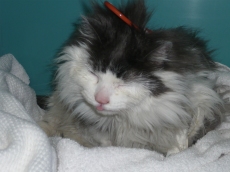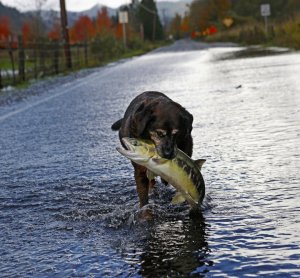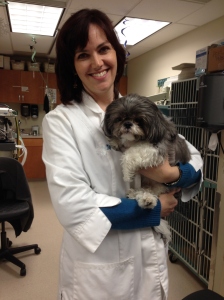If you walk into any pet supply or grocery store you will find an aisle (maybe more) filled with products promising to make your dog or cat smarter, faster, leaner, prettier, more energetic, better smelling, etc. The list of advertised benefits of any given supplement or nutraceutical goes on and on.
As you read in Part 1 of this series the supplement industry is heavy on business, but can be light on science and regulation. That doesn’t mean that there isn’t a place for supplements on your kitchen or clinic shelves. Today’s commercial pet foods (even those at the economy price point) provide all of the known essential nutrients your dog or cat needs without anything being added, but there are a few condition where adequate may not the same as optimal.
I’ve put together a list of what I consider to be my Top 5 Dietary Supplements for health and wellness. Not all of them (or maybe any of them) will be right for your dog or cats, but they are worth getting to know a little better.
So without further ado…
Dr. Weeth’s Top 5 Dietary Supplements

If only we all had a coat that glistened in the sun…
1. Essential Fatty Acids (EFAs): A balance of linoleic acid (LA; an 18-carbon length essential omega-6 fatty acid) and alpha-linolenic acid (ALA; an 18-carbon length essential omega-3 fatty acid) is necessary in dogs to maintain the normal water barrier function of skin and to maintain the suppleness of the hair coat.
Dogs that aren’t getting enough of one or both EFAs can have dull, dry, hair coats, with skin flakes (dandruff) and excessive shedding. These are the dogs that seem to shed a whole other dog when you brush them out. Yes, shed happens, but it happens more robustly when your dog isn’t getting the right amounts or ratio of EFAs in the diet.
The specific amounts required by an individual animal will depend on the overall balance of fats and fatty acids in the diet as well as breed differences in coat texture and length, which means that even diets marketed as “complete and balanced” may miss the EFA mark for optimal skin and coat health in a given individual. Supplementing higher levels of ALA has been shown to help improve skin and coat quality in otherwise healthy dogs and may help decrease itchiness in those with allergic or atopic dermatitis.
- Who would benefit? Otherwise healthy dogs with dry, flaky skin or with excess shedding; dogs with dermatitis caused by an allergic reaction (e., abnormal and excessive immune reactions to food, flea, environmental triggers) or atopy (i.e., abnormal and excessive immune reactions to an unknown trigger).
- How to get it? Many of the powders, pills, and chew that are marketed to “complete” a commercial diet for dogs and cats are simply dressed up ground flaxseed, a source of the essential omega-3 fatty acid ALA. Corn on the other hand (an oft demonized, but utterly delicious cereal crop) is high in the essential omega-6 fatty acid LA. Adding ground flaxseed doesn’t have magic fairy dust-like properties, it simply balances the LA:ALA ratio in most commercial diets, which supports a healthier skin barrier and allows the shedding fur to slip past each other instead of “felting” and coming out in clumps.
- Use with caution in dogs with a history of pancreatitis or other fat intolerances (hyperlipidemias or diarrhea). Care should also be taken in animals with suspected or document allergies as many of these flaxseed-based multivitamin/multimineral/fatty acid supplements contain additional proteins that could trigger or exacerbate an allergic response.

SAMe and the liver, a happy pair.
2. S-Adenosyl-Methionine (SAMe): SAMe is normally made in the liver of all animals. It serves as a precursor to taurine (an amino acid) and glutathione (an antioxidant); supports liver cell regeneration; and helps the liver metabolize a number of different compounds and drugs. All features that make SAMe an attractive supplement for animals with liver disease when SAMe production is decreased.
Scientific evidence for SAMe’s use in dogs and cats with primary liver disease is largely anecdotal or based on in vitro (cell culture) tests, though SAMe supplementation has been shown to protect the liver from toxic side effects of CCNU (a type of chemotherapy drug) in dogs undergoing cancer treatment and may improve behavioral traits in dogs experiencing age-related declines in cognitive function (old dogs that start to act like old dogs). Similar cancer treatment and geriatric studies have not been published in cats, but SAMe supplementation has been shown to limit the effects of acetaminophen (the active ingredient in the pain reliever Tylenol) toxicity.
- Who would benefit? Dogs with congenital or acquired liver disease; dogs undergoing cancer treatment; older dogs in general; and cats exposed to acetaminophen. Cat with liver disease and geriatric cats may benefit form SAMe supplementation as well, but without published evidence on its use, SAMe for cats falls into the category of “not harmful, possibly helpful” so worth a try if you can give pills to your cat.
- How to get it? There are a number of commercial SAMe supplements sold for both veterinary and human use and either type may work for your dog or cat. When selecting supplements (marketed for pets or people) it is important to know that SAMe is prone to degradation during manufacturing and storage so capsules and enteric coated pills are better than chewable wafers.
- Another key consideration when supplementing SAMe is that it undergoes a significant first-pass metabolism with approximately 50% of the ingested SAMe being metabolized by the liver before it can be used as SAMe itself. Additionally, the presence of food in the stomach can decrease absorption of SAMe even further, meaning that SAMe supplements should be given on an empty stomach at least 1 hour before a meal to have maximal absorption.

Everybody poops, but maybe probiotics could help them poop better.
3. Probiotics: Probiotics are beneficial bacteria, such as Lactobacillus, Bifidobacter, and Enterococcus, that may help support normal colon cell health and normal gut-associated and whole-body immunity. They do this by inhibit growth of more pathogenic intestinal bacteria strains; enhancing immune function at the level of the gut; and exerting a trophic (growth-like) effect on the intestinal cells themselves.
In otherwise healthy animals, probiotic supplementation may not give your dog or cat perfect poops or make them extract more nutrients from their diet (both marketing claims I’ve seen), but it may help swing the balanced of colonic bacteria away from potentially pathogenic strains such as Clostridia perfringens.
Clostridia overgrowth is associated with acute diarrhea in dogs and cats so theoretically reducing their numbers may have longer-term health benefits. In dogs and cats with acute diarrhea or in dogs with chronic intestinal diseases probiotic supplementation may actually help normalize the colonic bacterial environment (what is called the gut microbiome) and improve clinical signs of soft stool and diarrhea more rapidly than when medical treatments (antibiotics and immune-modifying medications) are given alone. The beneficial effects of probiotics may also extend beyond the gut itself. For example, probiotic supplementation may improve clinical signs of atopic dermatitis in dogs.
- Who would benefit? Dogs and cats experiences chronic or acute diarrhea; dogs with atopic or allergic dermatitis.
- How to get it? Probiotics marketed for pets or people can be used to provide a source of beneficial intestinal bacteria, though certain veterinarian strains may be more effective in cats and dogs than the human counterparts. There is also variability between product strains and in manufacturing and stabilization processes, so I recommend using a probiotic supplement from a reputable manufacturer.
- Unfortunately, the amounts of probiotic bacteria found in fermented foods like yogurts and kefirs are relatively low compared to what is found in a supplements capsule or wafer so you are better off with giving a good quality probiotic supplement rather than relying on a daily yogurt treat. It is also important to know that even the best probiotic supplement won’t be enough to correct diarrhea by itself. If your dog or cat is having diarrhea that lasts for more than 24 hours you should seek veterinary care and treatment sooner rather than later. Your pet and your floors will thank you.

This old dog has the right idea.
4. Fish Oils: Fatty fishes like salmon, cod, and menhaden are high in the long-chain omega-3 fatty acids eicosapentaenoic acid (EPA) and docosahexaenoic acid (DHA).
DHA is incorporated into the fatty insulation of nervous tissue and is essential for normal eye and brain development of puppies. EPA on the other hand isn’t essential in the diet (meaning your dog or cat will survive if fish oils are left out), but in adult animals increased intake of EPA can help decrease production of pro-inflammatory mediators and help manage arthritis pain, atopy, kidney disease, heart disease, lymphoma treatment, and may help support brain health in older dogs and cats .
- Who would benefit? Older dogs and cats, especially those with chronic diseases, such as heart or kidney disease, or that are being managed for inflammatory conditions, such as skin or intestinal allergies.
- How to get it? Fish oils can be given as either a liquid or capsule, but manufacturer quality control is essential. Supplements should be checked to be free of environmental contaminants (e.g. mercury or PCBs) or excess levels of vitamins A and D, which can be toxic to dogs and cats. Product quality and testing should be done by every fish oil manufacturer, so it is worth spending a little time looking into manufacturers before spending your money.
- Caution should be used when adding fish oil to cat diets as platelet abnormalities and bleeding disorders have been reported in cats receiving high dosages of EPA. Additionally, increased intake of EPA and DHA will increase the requirement for vitamin E in the diet. Without enough vitamin E cats fed high fish oil diet are at risk of developing painful inflammation in their fatty tissues (called pansteatitis).
- Added Note: Fish oil should not actually smell “fishy”; this odor change occurs when the fatty acids in fish oil begin to break down from improper handling or storage. You should also be forewarned, as the long-chain fatty acids from fish oil are incorporated into every cell in your pet’s body they will eventually be incorporated into skin oils, which will begin to oxidize giving your dog or cat a distinct fishmonger aroma.

Old dogs have old joints. Could supplements keep those joints young?
5. Glucosamine/Chondroitin Sulfate: Synovial joints (ones that allow movement between bones) are composed of cartilage matrix (the proteoglycans hyaluronic acid and glucosaminoglycans -or GAGs for short), collagen, and water. Inflammation in the joint (arthritis = arthr– joint + –itis inflammation) can result in damage to the joint tissues and potential loss of chondrocytes (the cells that line the joint and product the matrix proteins).
Oral glucosamine and chondroitin sulfate supplements have been theorized (and marketed) to provide precursors to matrix GAGs and help improve mobility in animals with arthritis, but results of clinical trials on glucosamine and chondroitin sulfate supplements have been mostly disappointing. Lack of efficacy in controlled clinical trials could mean that these supplement just don’t work, or maybe failure of a response is related to the severity of existing damage to the joint and degree of chondrocytes loss rather than complete futility of glucosamine and chondroitin sulfate supplements in all animals.
I wonder if we have been looking at these supplements the wrong way. Maybe oral glucosamine and chondroitin sulfate supplements are more chondroprotective rather than chondroreplacive (I think I just made up a new word), and should be started before damage (or at least significant damage) has occurred. This would be a very difficult to prove or disprove in clinical trials, but since glucosamine and chondroitin sulfate supplements appear to be relatively safe for both dogs and cats, they fall into the “possible helpful, but not harmful” category.
- Who would benefit? Canine athletes, feline athletes (if such a creature existed), and possibly every middle age to geriatric dog or cat.
- How to get it? Veterinary and human glucosamine and chondroitin sulfate supplements are available. Veterinary supplements are often flavored to increased acceptance by dogs and cats, but a number of human supplements products may contain comparable amounts of glucosamine and chondroitin sulfate.
- Caution should be used if you are considering giving a human supplements as some joint health products may include additional nutrients (like high levels of vitamin D) or herbal mixtures that have not been safety tested in dogs and cats. Occasionally vomiting has been reported in dogs given glucosamine and chondrointin sulfate supplements, but this appears to be caused by stomach irritation rather than any innate harmful effects of the supplement.
The reality of nutrition is that it is not one-size-fits-all. Needs will vary based on breed, life stage, health status, and activity level. Even though commercial pet foods from good quality manufacturers (check out this link to help define “good quality manufacturers”) will provide all of these essential nutrients at levels adequate for survival, what is adequate for day-to-day living in one animal may not be the same as what optimizes health and wellness in another. This is where supplements come in.
And one last note: Supplements should never replace proven medical treatments for your dog or cat, but when added to a balanced diet, regular exercise, and preventative veterinary care, could help keep them feeling good for years to come.
Happy Feeding!
Lisa P. Weeth, DVM, MRCVS, DACVN
